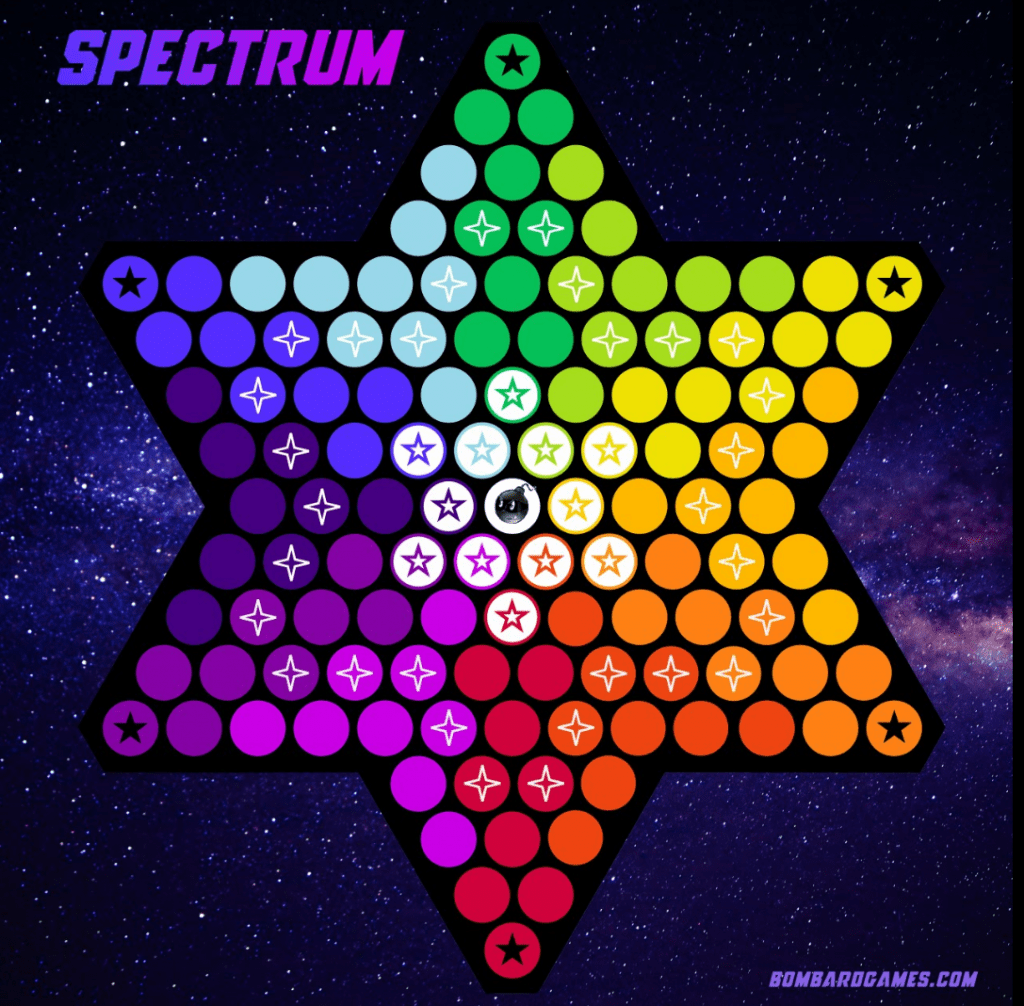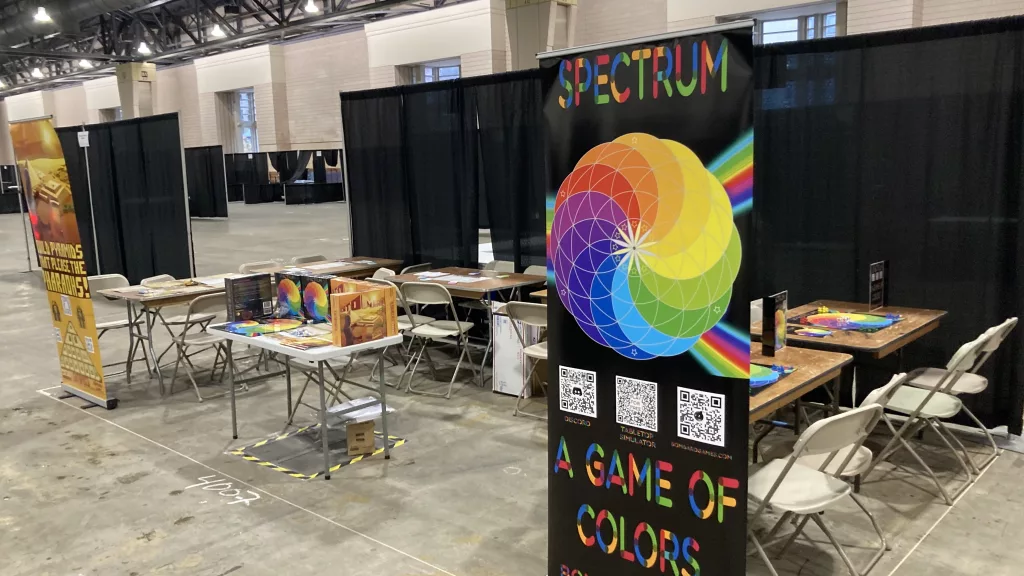Board Game Designer Diary – Spectrum
The Story of Spectrum – A Game of Colors
Part I – The Board Game
The Spectrum board game started with the idea of having a game that had no math, or as little as possible, in it. Something that would be simple to learn, accessible regardless of language, but have a great deal of strategy and replayability. One of the things that is fairly universal regardless of age, nationality, creed etc… are colors.
Thus began the genesis of Spectrum being a game of colors. That decided, it was a matter of finding inspiration. The inspiration came in the form of a Chinese Checkers board. It seemed as though it was a game that you could almost look at and grasp what the object was, it used colors, it had little math, and it was replayable. It was just a bit dated and boring for the 21st century.

The first version of the Spectrum board is actually a direct copy of a Chinese Checkers board with the 12 colors utilized and set in a semi-linear path. The 6 tipped star layout is what led to the idea that players could only enter on the 6 primary colors. To get into the 6 new colors, the pawn would need to already be in play.
The dice came next. The reason for using d6 followed from the idea that players would only be able to enter on Primary colors. The inspiration that the secondary color between two primary colors opened when a roll showing the two primary colors that were next to each other happened was the next piece of the puzzle. Thus the two kinds of rolls were established; Primary colors next to each other & Primary colors not next to each other.
Dealing with the roll of doubles was fairly straightforward. Most games award rolling doubles or triples so giving a movement award for doing so seemed natural. The idea of it opening the color on the bottom of the dice and the surrounding secondary colors again played to the traditional reward for rolling doubles. With that, the 3 rolls of Spectrum were set as special rolls took the third spot.

Movement would be made as simple as possible. Players would be allotted 2 movement spaces each turn. The dice would determine what colors were open for movement, and special rolls would give bonus movement points and open more colors.
The idea of adding more dice into the game as it progresses was done to accomplish two things. The first is to keep the options each turn open as colors close. Players need more color options to choose from later in the game as they have less and less colors where it is advantageous to move. The second reason was to give the game some kind of feel of building to a crescendo or climax. With 4 dice and 30 pawns on the board, the amount of possible moves becomes enormous and which one is the best one becomes a very tricky affair.
Next was to add in Player Interaction. In the original rule, capturing(landing on an opposing pawn) would allow you to send them back to a starting space, while jumping an opponent would eliminate the pawn from the game. This pawn elimination mechanic was quite fun, but it became unbalanced in 3 player games once it was determined that you could eliminate a player simply by ganging up and jumping all their pawns leaving them with too few pawns to capture enough colors to win.
The goal of Spectrum being the capture of a set amount of the colors by moving from outer edge to center came naturally. Born in the Chinese checkers restriction of entering from a star tip, the idea of going from outside in, instead of the more familiar inside out, gave Spectrum a unique feel.
After being played 100s of times by dozens of people, Spectrum was pitched to AEG at Pax Unplugged 2021. It was selected to move on to stage 2, but with AEG down to producing only 5 games a year, the competition is fierce and the wait time to production is over 2 years. It fell out of the AEG pitch funnel and came back to Bombard Games.
Once back, the game needed more work. First was the board. The Chinese Checkers board was fine for play but it was not original. The final design seen on Spectrum today is the result of 2 patterns being drawn up to replace the cc board. The simplistic, clean nature of the colorful pinwheel appealed to everyone who sees it. While they may not love the game, almost everyone agrees that the board is nice to look at.
Next fix, jumping. Jumping still was a good mechanic, but it needed to be tweaked. The tweak came from turning a jump from something bad happening to the opponent into something good happening for the jumper. The jump rule was changed such that pawns were not eliminated, but the jumper could jump further than 2 spaces onto any space that simply touched(a side or corner) of the jumped space. With that change, the tactic to eliminate other players was removed and the game became a much more strategic affair.
With the new board pattern and jumping fixed, Spectrum was basically in the state it is now in mid 2022. The next goal was to bring it to Pax Unplugged 2022 and test it on the unsuspecting public.
In short, the testing at Pax Unplugged went spectacularly. Hundreds of people came up to learn about the pretty game and play it. Spectrum made Quackalope’s Top 10 Indie Games at Pax. The Boda Games rep stopped by, leading to selecting them as the manufacturer. People wanted to know where they could buy the game. It was the affirmation needed to take Spectrum to the crowdfunding community and try to get the game into production.
So it was back into the lab to address color blindness. The playtesting at pax resulted in much needed edits, clarifications and updates to the Spectrum rulebook. The Pax testing also led to the Surrender rule which was actually the idea of a playtester which would need to be tested.
We will get into all that and the unusual inspiration that led to the creation of the Spectrum Cards in Part II of The Story of Spectrum. Until then, thanks for reading and Happy Gaming!



